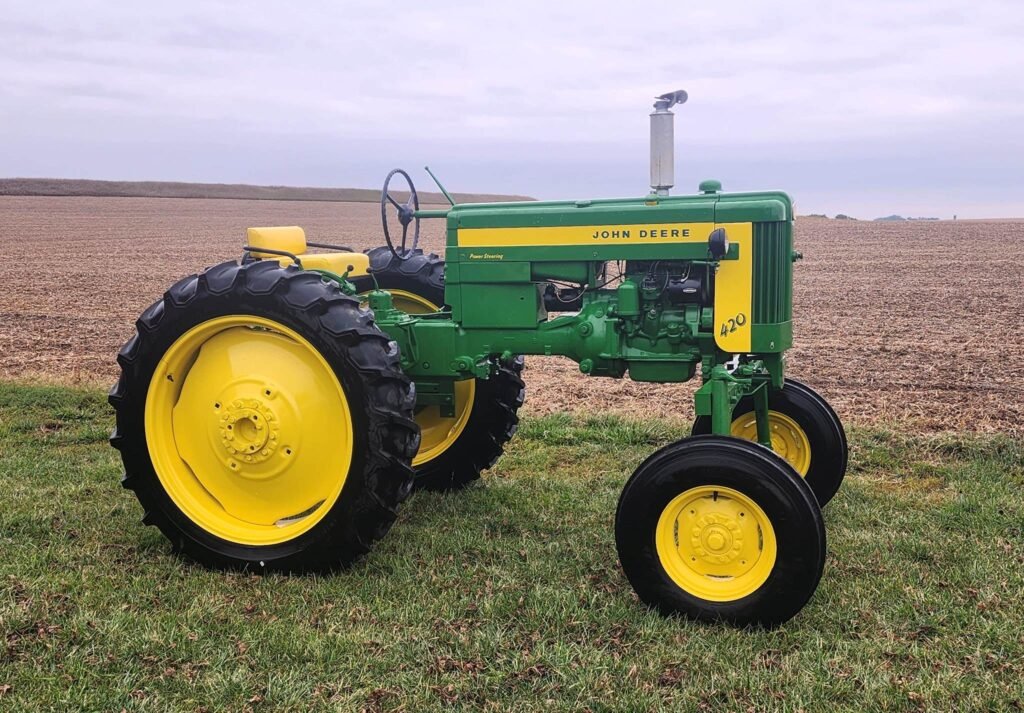InsightGirl Verdict
The John Deere 420 is a compact classic from the golden age of American farming—simple, reliable, and still surprisingly capable for light-duty work or collectors with a soft spot for green iron.
Pros
- + Iconic two-cylinder sound and simplicity
- + Reliable and easy to repair
- + Fuel efficient and cost-effective to run
- + Great visibility and straightforward controls
- + Widely supported by collectors and parts suppliers
- + Multiple variants (utility, crawler, hi-crop, etc.)
- + Lightweight and nimble for small farms or yards
- + Excellent for vintage shows, hobby work, or mowing
Cons
- – No modern safety features (no ROPS, seatbelt)
- – Low horsepower limits heavy-duty tasks
- – Narrow front-end models can be tippy on slopes

The John Deere 420 isn’t trying to be the biggest, baddest machine on the farm—it’s just trying to get the job done. And for a whole generation of small-acreage farmers, that was more than enough. Produced from 1956 to 1958, the 420 was part of Deere’s “20 Series” refresh—an era where classic design met incremental innovation. With around 26 horsepower and a lineup of configurations that ranged from row-crop to crawler, the 420 was the do-it-all machine for folks who didn’t need 100 horses under the hood.
Today, it’s more collector’s item than field tool, but don’t let the shine fool you—plenty of 420s are still out there mowing, raking, and cultivating like it’s 1958.
What’s New for This Generation?
At the time, plenty. Compared to the outgoing Model 40, the 420 came with improved hydraulics, a slight power bump, and later models offered a five-speed transmission. Deere didn’t reinvent the wheel—they just made it roll a little smoother.
For today’s users, the 420 hasn’t changed one bit. No updates, no electronics, no emissions tech. And that’s exactly the appeal.
Pricing and Best One to Buy
Back then, you could drive one home for under $2,500. These days, a working example typically lands between £1,500 and £5,000. Restored models in parade-ready shape? Expect closer to £6,000, especially if it’s a rare variant like the 420C crawler or 420V high-crop.
Best picks:
- 420T (Tricycle): The quintessential classic, ideal for narrow row crops and tight turns.
- 420W (Standard wide front): Better balance and loader-friendly.
- Later serial numbers (1957–58): You’ll get the 5-speed gearbox and updated styling.
Engine, Transmission, and Performance

Under the hood is a 2-cylinder gasoline engine that gives the 420 its signature putt-putt sound—slow, steady, and instantly recognisable. With around 26 PTO horsepower, it’s no powerhouse, but it’s got a surprising amount of grunt at low RPMs.
Available transmissions included:
- 4-speed manual: Simple and effective.
- 5-speed manual (on later models): A welcome upgrade with better gearing for field work.
This is a machine that thrives on simplicity. It’s not fast (top speed is about 11 mph), and it’s not flashy, but it’ll happily tow a rake, run a sickle mower, or handle small-scale tillage with minimal fuss.
Fuel Consumption and Real-World Use
Lightweight, fuel-efficient, and mechanically straightforward—the 420 is about as low-maintenance as a vintage tractor gets. It runs on petrol, burns modest amounts, and starts well with a fresh battery and a bit of choke.
You’ll see it most often on:
- Hobby farms
- Orchards or vineyards
- Small hay operations
- Classic tractor shows (where it still turns heads)
Interior, Comfort, and Operator Experience
No cab, no frills—just a steel seat, a tall shifter, and the open sky. The 420 offers a pure, seat-of-the-pants driving experience. That said, the controls are well laid out, visibility is excellent, and everything falls to hand like it was designed by someone who actually used it.
It’s the kind of tractor that teaches you how to drive a tractor—simple, honest, and forgiving.
Infotainment and Connectivity
None. But you won’t miss it. The only soundtrack here is mechanical: two-cylinder rhythm, gear whine, and wind in the trees. That’s more satisfying than any playlist.
Safety and Ease of Use

Let’s be honest: safety wasn’t front and centre in the 1950s. The 420 lacks modern ROPS, seatbelts, or hydraulic brakes. But it’s also light and relatively slow, with intuitive controls and great visibility.
As with any vintage iron, the key is respect—know your terrain, keep it in gear on hills, and don’t let that narrow front end fool you into taking tight turns at speed.
Maintenance and Reliability
The 420 is one of those tractors that just keeps going. Basic maintenance—oil, plugs, filters—and it’ll run for decades. Parts are widely available, and you can wrench on it with hand tools and a bit of common sense.
Better yet, there’s a deep community of collectors and restorers, so knowledge and support are easy to find.
Verdict
The John Deere 420 isn’t going to outpull modern compacts or work 500 acres solo—but that’s not the point. It’s a reminder of what tractors used to be: simple, mechanical, and utterly dependable. Whether you’re mowing a few acres, running a hay rake, or just enjoying a piece of farming history, the 420 delivers.
It’s a working-class classic that still earns its keep—and earns plenty of nods at the local tractor pull.
Specifications
General Information | |
| Manufacturer | John Deere |
| Model Name | 420 |
| Vehicle Type | Utility Tractor |
| Body Style | Row-Crop / Utility / Crawler |
| Production Years | 1956–1958 |
| Manufacturing Location | Waterloo, Iowa, USA |
| Original Price (1958) | ~$2,000 USD |
Power and Performance | |
| Engine Type | John Deere 2-Cylinder Gasoline |
| Engine Displacement | 1.9 litres (113 ci) or 2.2 litres (135 ci) depending on variant |
| Horsepower (PTO) | 26–30 hp (19–22 kW) |
| Horsepower (Drawbar) | 24 hp (18 kW) |
| Rated Engine Speed | 1850 rpm |
| Torque | Approx. 84 Nm (62 ft-lbs) |
| Fuel Type | Gasoline / All-Fuel / LP-Gas |
| Fuel Capacity | 39.7 litres (10.5 US gal) |
Transmission and Drivetrain | |
| Transmission | 4-Speed or 5-Speed Gear Transmission |
| Gears | 4 or 5 Forward / 1 Reverse |
| Drive Type | 2WD |
| Clutch | Dry disc |
Hydraulics and PTO | |
| Hydraulic System | Open center (Touch-O-Matic) |
| Pump Flow | Up to 8.5 gpm (32 lpm) |
| Rear PTO | 540 rpm |
| Rear Hitch | Optional 3-point conversion |
| Lift Capacity | Not officially rated |
Dimensions and Weight | |
| Length | 2,800 mm (110 in) |
| Width | 1,650 mm (65 in) |
| Height (steering wheel) | 1,600 mm (63 in) |
| Wheelbase | 1,800 mm (71 in) |
| Weight (Shipping) | 1,230 kg (2,710 lbs) |
| Weight (Operating) | 1,450 kg (3,200 lbs) |
| Ground Clearance | 330 mm (13 in) |
Notable Features | |
| Steering | Manual or power steering (optional) |
| Brakes | Mechanical expanding shoe |
| Lighting | Basic front and rear lamps |
| Instrumentation | Ammeter, oil pressure, temp gauge |
Variants | |
| 420T (Tricycle) | Narrow front-end for row-crop use |
| 420U (Utility) | Lower stance for general farm work |
| 420C (Crawler) | Tracked version for tough terrain |
| 420H (Hi-Crop) | Increased clearance for tall crops |
Available Paint Colours |
| Classic John Deere Green with Yellow Wheels |





